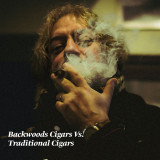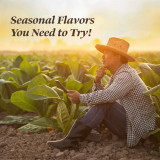Explore Deadwood Tobacco: Unique Features That Set It Apart

In today’s competitive premium cigar market, Deadwood Tobacco stands out with its rich history, complex flavor profiles, and innovative blends. This article briefly covers its origin, unique blends, distinctive cigar lines, comparisons with competitors like Drew Estate, essential beginner tips, purchasing guidance, and community engagement.
What Is the History and Origin of Deadwood Tobacco?
Deadwood Tobacco’s origins lie in a legacy of artisanal craftsmanship and centuries-old tobacco traditions. Its visionary founder combined traditional tobacco curing with innovative drying and fermenting techniques to preserve natural flavor nuances and create a cigar suited to modern preferences for complexity and balance.
How Did Deadwood Tobacco Begin and Who Founded It?
An entrepreneurial pioneer, whose name is synonymous with quality, established Deadwood Tobacco. By exploring diverse tobacco strains and regional curing practices, he formulated a distinctive blend that balanced robust aromas with lighter, aromatic touches. His commitment to reinvigorating tobacco traditions underpins the brand’s enduring reputation.
What Are the Key Milestones in Deadwood Tobacco’s Development?
Deadwood Tobacco quickly distinguished itself by introducing a proprietary fermentation process that enhanced natural sugars and spices. International recognition followed, with numerous awards at prestigious cigar competitions affirming its artisanal methods and innovative production techniques.
Where Are Deadwood Cigars Made and What Is Their Geographic Origin?
Handcrafted in renowned cigar-producing regions, Deadwood Cigars benefit from ideal microclimates and rich soils found in parts of Latin America and the southeastern United States. This geographic heritage contributes both to exceptional quality and to the nuanced flavors valued by aficionados.
What Unique Blends and Flavor Profiles Define Deadwood Tobacco?
Deadwood Tobacco’s distinctiveness is rooted in its careful leaf selection and proprietary blending process. By experimenting with various curation techniques, it produces cigars with layered, complex profiles that cater to both new smokers and long-time enthusiasts.
Which Flavor Notes Are Most Prominent in Deadwood Cigars?
Deadwood Cigars are celebrated for flavor notes that include dark chocolate, caramel sweetness, nutmeg, subtle black pepper, and oak. These elements create a balanced experience where the natural sweetness of tobacco is complemented by spice and earthiness, achieved through meticulous aging and blending.
How Do Wrapper, Binder, and Filler Types Influence Deadwood’s Flavor?
Each component plays a critical role: the wrapper offers initial sweetness and spice, the binder adds subtle earthiness, and the filler provides core flavors such as caramel and dried fruit. This deliberate balance results in a harmonious and evolving flavor profile with every draw.
What Are the Signature Wrapper Types Used by Deadwood Tobacco?
Deadwood Tobacco employs signature wrappers like Connecticut Broadleaf and Cameroon. The Connecticut Broadleaf wrapper provides a naturally oily, dark finish with deep caramel and subtle spice, while the Cameroon wrapper adds hints of dried fruit and pronounced sweetness—all enhancing both flavor and visual appeal.
What Are the Distinctive Features of Popular Deadwood Cigar Lines?
The brand offers several cigar lines, each with a unique identity appealing to a range of tastes from exceptionally sweet to robustly complex. Their distinctive construction, blend, and aging process underscore Deadwood’s commitment to quality and differentiate its products in a crowded market.
What Makes Deadwood Sweet Jane Stand Out?
Deadwood Sweet Jane is known for its smooth, mellow smoke and underlying sweetness that appeals to those preferring a gentler flavor profile. Its balanced construction, enhanced by a premium Connecticut Broadleaf wrapper, highlights natural tobacco sugars without overwhelming intensity.
How Does Deadwood Fat Bottom Betty Compare in Flavor and Construction?
Engineered for a fuller body, Deadwood Fat Bottom Betty delivers a complex blend with pronounced dark caramel, nutmeg, and robust earthiness. Its careful selection of binder and filler creates a dense, evolving smoke, offering a bolder experience for smokers seeking a full-bodied taste without losing balance.
What Are the Characteristics of Deadwood Crazy Alice?
Targeted at adventurous smokers, Deadwood Crazy Alice features an unconventional blend with tangy spice and subtle herbal notes. Its lighter yet flavorful draw provides an intricate tapestry of flavors that evolve uniquely from the first puff to the last, marking a creative departure from traditional profiles.
How Does Deadwood Tobacco Compare to Competitor Brands Like Drew Estate?
Deadwood Tobacco distinguishes itself from brands like Drew Estate through its emphasis on artisanal methods and historical legacy. Its unique flavor profile, developed by a proprietary blending process, caters to a niche that values traditional quality combined with modern refinement.
What Are the Key Differences Between Deadwood and Drew Estate Cigars?
Deadwood focuses on classic, balanced smoking experiences enhanced by innovative flavor techniques. In contrast, Drew Estate often experiments with more aggressive, modern blends. This difference in blending philosophy appeals to smokers with differing taste preferences: those seeking sophistication prefer Deadwood, while experimental users lean toward Drew Estate.
How Does Deadwood Tobacco Differ From Other Premium Cigar Brands?
Deadwood Tobacco revitalizes old-world tobacco practices using modern precision. Its fusion of heritage techniques with contemporary blending results in cigars that deliver classic tobacco nuances alongside layered, refined modern tastes—offering a premium experience that sets it apart.
What Value Does Deadwood Offer Compared to Its Competitors?
Deadwood Tobacco’s holistic crafting approach and commitment to quality deliver superior taste consistency. This makes each cigar not just a smoke but an immersive experience—a deep connection to tobacco heritage coupled with refined flavor innovation that resonates with discerning consumers.
What Should Beginners Know About Deadwood Tobacco and Cigar Smoking?
For those new to cigar smoking, understanding Deadwood Tobacco can initially be daunting. However, grasping fundamentals such as proper cutting, lighting, and tasting techniques, along with recognizing the impact of wrapper, binder, and filler choices, greatly enhances the smoking experience and appreciation of fine cigars.
How Do You Properly Cut and Light a Deadwood Cigar?
A clean cut with a sharp guillotine cutter ensures a smooth draw. Toasting the cigar’s foot before drawing allows the flame to evenly envelop the tobacco, preventing harsh flavors and contributing to a consistent burn that preserves the intended blend.
What Are the Basics of Cigar Wrapper Types and Their Impact?
Understanding wrapper types is key; for instance, Connecticut Broadleaf offers creamy sweetness, while darker wrappers like Maduro or Cameroon provide richer spice and complexity. Recognizing these differences helps predict and match flavor profiles to personal taste.
How Can You Identify Flavor Profiles When Smoking Deadwood Cigars?
Pay attention to changes during smoking: note the initial sweetness, the mid-smoke evolution of spice, and the final aftertastes such as nuttiness or earthiness. Frequent practice sharpens the palate and enhances recognition of the intricate flavors engineered by Deadwood Tobacco.
Where Can You Buy Deadwood Tobacco Cigars and What Are Their Price Ranges?
Deadwood Tobacco Cigars are available from reputable brick-and-mortar smoke shops and specialized online stores. These retailers offer diverse product lines, ensuring options for both novices and seasoned aficionados, with prices reflecting the care in artisanal production—from approximately US$10 to US$25 per stick, with special editions priced higher.
What Are the Best Retailers and Online Stores for Deadwood Cigars?
Top retailers include high-end smoke shops and select online platforms known for their quality service and authentic products. Detailed product descriptions, customer reviews, and exclusive offers on these sites help buyers appreciate the distinct attributes of each cigar.
How Much Do Deadwood Cigars Typically Cost?
With prices generally ranging between US$10 and US$25 per cigar, the cost reflects the meticulous cultivation, curing, and blending that goes into each product. Limited editions or special releases may command higher prices, underscoring their collectible status.
Are There Limited Editions or Special Releases Available?
Yes, Deadwood Tobacco frequently releases limited editions featuring exclusive blends, unique wrapper types, or refined aging methods. These limited series, often presented in numbered boxes or special packaging, are especially prized by collectors and enthusiasts.
How Can You Engage With the Deadwood Tobacco Community and Stay Updated?
A vibrant community of Deadwood Tobacco aficionados exists online through forums, cigar blogs, and social media groups. These platforms allow both beginners and experts to share reviews, discuss flavor profiles, and exchange recommendations, enhancing overall market reputation.
Where Can You Find Reviews and Discussions About Deadwood Cigars?
Dedicated cigar forums, social media pages, and specialized review websites offer in-depth discussions on flavor, construction, and overall value. Live tasting events and Q&A sessions on these platforms provide interactive opportunities to engage with experienced smokers.
How Does Community Feedback Influence Deadwood Tobacco’s Reputation?
Constructive community feedback guides Deadwood Tobacco in refining its blending and production techniques. Positive reviews reinforce consumer trust, while critical insights help the brand adjust to evolving tastes, maintaining its premium quality and innovative edge.
What Are the Latest Trends and Releases in the Deadwood Tobacco Line?
Recent trends include rare wrapper blends, enhanced aging processes, and limited-edition series that emphasize sustainable practices. These innovations ensure that Deadwood Tobacco remains at the forefront of market evolution while honoring its traditional craftsmanship.
Table: Comparison of Key Attributes Between Deadwood Tobacco and Competitors
Before the table, note that Deadwood Tobacco’s unique heritage and innovative methods offer distinct advantages.
|
Attribute |
Deadwood Tobacco |
Drew Estate |
Other Premium Brands |
|
Craftsmanship |
Artisanal, traditional blending |
Modern, experimental blends |
Varies |
|
Flavor Profile |
Balanced, nuanced sweetness & spice |
Bold, sometimes aggressive |
Typically balanced |
|
Production Methods |
Proprietary aging and fermentation |
Innovative, tech-driven |
Traditional methods |
|
Market Position |
Heritage meets modern innovation |
Trendy, youth-oriented |
Classic sophistication |
|
Limited Editions |
Frequent, collectible releases |
Occasional special releases |
Sporadic |
After reviewing the table, consumers can appreciate how these distinctive attributes translate into superior smoking value and style, setting Deadwood Tobacco apart in both taste and artisanal quality.
Final Thoughts
Deadwood Tobacco merges storied heritage with innovative production to create premium cigars that command attention. From Sweet Jane’s balanced sweetness, Fat Bottom Betty’s robust complexity, to Crazy Alice’s adventurous blend, each line offers a unique smoking journey. For both beginners and connoisseurs, understanding the intricacies of cigar construction and flavor enhances the experience, while active community engagement ensures the brand continues to evolve and excel.
Frequently Asked Questions
What makes Deadwood Tobacco’s flavor profiles unique?
The brand’s proprietary blending and aging techniques yield distinct, balanced flavors with hints of caramel, spice, and subtle oak.
How can beginners best appreciate Deadwood Cigars?
By mastering proper cutting, lighting, and recognizing the impact of wrapper, binder, and filler, beginners can fully enjoy each nuanced flavor.
Where is the heritage of Deadwood Tobacco rooted?
Its heritage is steeped in time-honored tobacco cultivation and curing traditions from regions with ideal microclimates.
What are some of the latest releases from Deadwood Tobacco?
Recent releases feature limited-edition blends and special wrapper series that emphasize sustainable practices and innovative aging methods.
How does community feedback impact Deadwood Tobacco’s products?
Feedback from the community drives continual refinement in blending and production, ensuring that each new release meets evolving consumer tastes while maintaining premium quality.
Recent Posts
-
Backwoods vs Traditional Cigars: Flavor & Experience
Cigars are celebrated for their unique flavors, meticulous craftsmanship, and cultural significance …11th Sep 2025 -
Best Cigar and Bourbon Pairings for Every Aficionado
Best Cigar and Bourbon Pairings for Every Aficionado Pairing a fine cigar with a glass of bourbon i …10th Sep 2025 -
Swisher Sweets Seasonal Flavors You Need to Try
In today's competitive tobacco market, swisher sweets has carved a niche with its innovative season …9th Sep 2025



